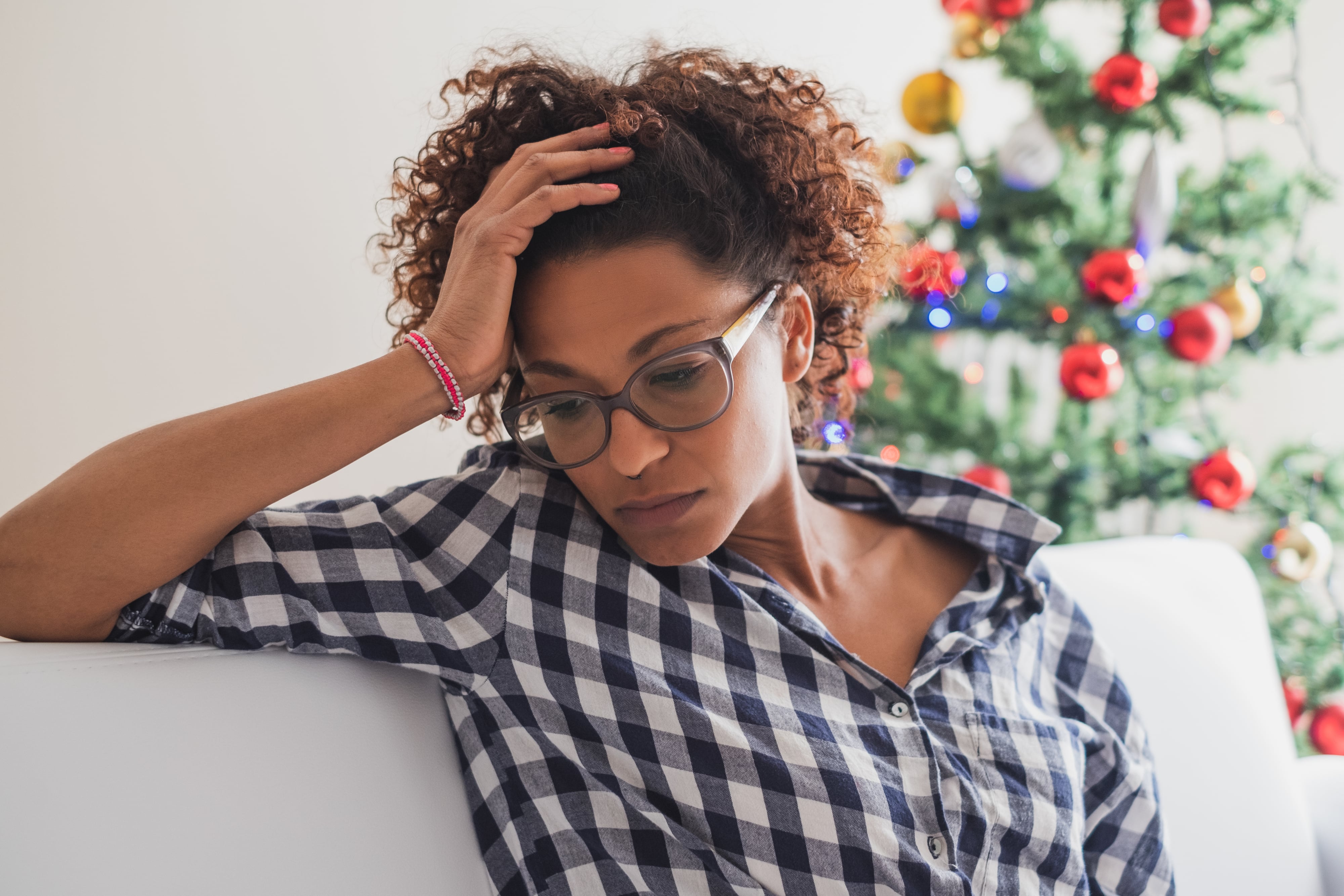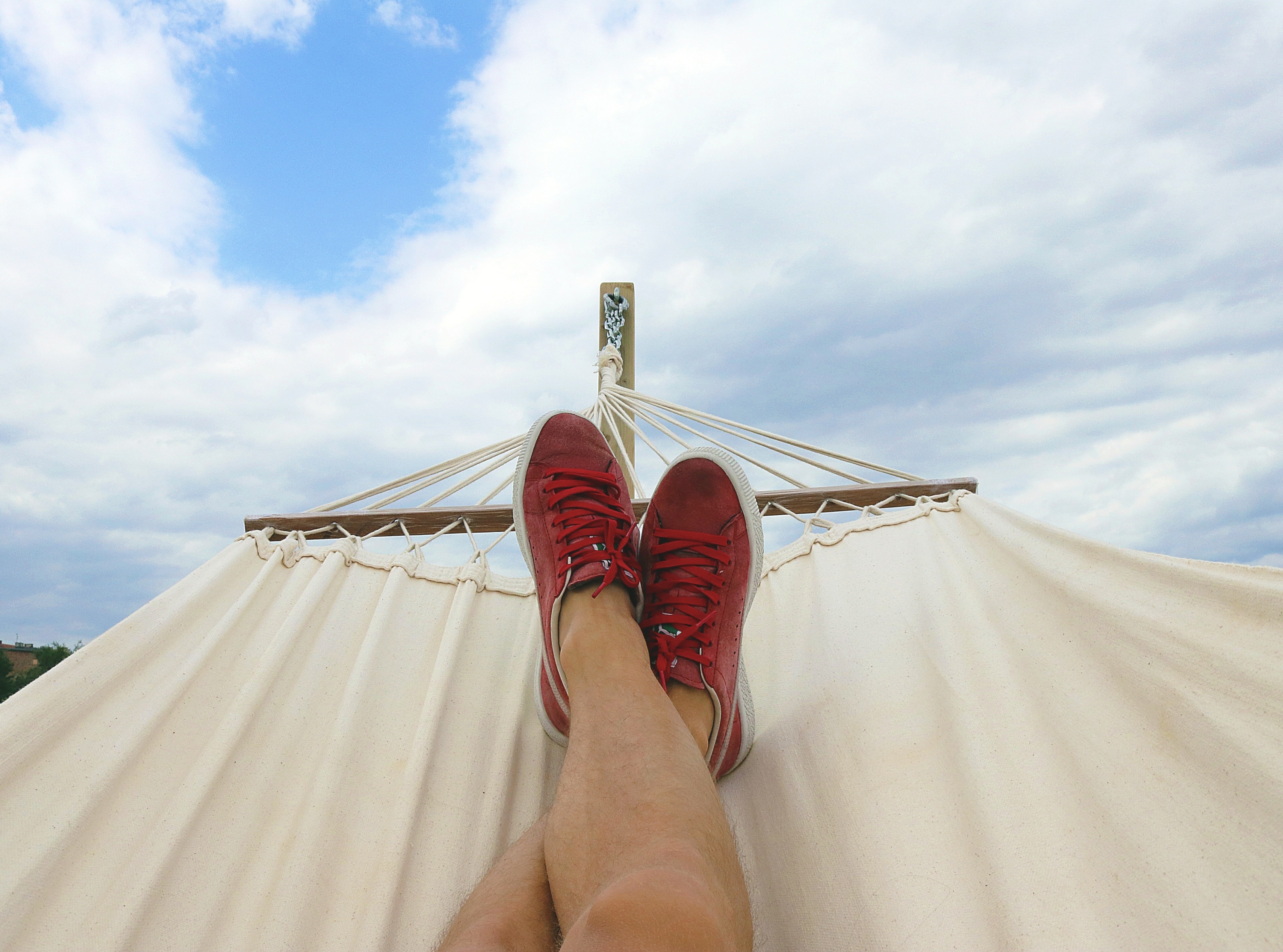Without question, the year 2020 will go down as one of the most eventful, trying, and devastating years in the last several decades. It has been a year where global health—physical, mental, and emotional—has taken center stage. At the same time, 2020 will also be remembered as the year where people came together to show support for first responders and essential workers, shared information and resources, and, ultimately, reflected on everyone’s individual role in ensuring common wellbeing.
2020 in Review
For many people, the defining element of 2020 has been the COVID-19 pandemic, which continues to devastate communities across the globe disproportionately and has caused 68 million infections and 1.5 million deaths to date.
Another defining element of this year has been the widespread unrest after the brutal killing of George Floyd, Breonna Taylor, and countless others by police. These events ignited the expansion of the Black Lives Matter, a movement that shed light on disparities in health, justice, security, and opportunities that affect BIPOC communities.
Other events that made 2020 one of the most difficult years in human history to date have been the devastating wildfires in Australia and California; the deaths of esteemed athletes, celebrities, and lawmakers like Kobe Bryant, Chadwick Boseman, and Ruth Bader Ginsburg; a massive explosion in Lebanon; a divisive presidential election in the US; the rolling back of an executive order that provided transgender individuals access to healthcare; and devastating floods and landslides in Central America after two back-to-back hurricanes.
Despite the incredibly trying events of 2020, some positive occurrences have come about. Some of these include an increased sense of social responsibility; a revival of flora and fauna life as people were in lockdown; widespread, though overdue, appreciation for frontline healthcare workers, essential workers, and teachers; empty animal shelters due to increased adoption rates; and a complete reinvigoration and increase of awareness around the importance of small businesses, especially those owned by BIPOC people and minorities, for community vibrancy, economic vitality, and human connection and support, including small, local shops, food producers, and restaurants.
Throughout all of these events, positive and unfavorable, all of the facets of human health—physical, emotional, and mental—have been highlighted as one of the most important things to uphold and protect.
Health, fitness, wellness, and nutrition coaches have a more important role than ever in the years and decades moving forward. As lifestyle choices, mental health, and the promotion of relevant, long-lasting, and community-specific health services take center stage as the drivers of individual and community-wide resilience, there is an increasingly important need for your knowledge and expertise.
In this two-part series, we look back at what the events of this year have taught the nutrition industry, and we turn them into lessons for the health and wellness industry, in general, and for health and wellness coaches to take into years to come to be part of the solution to difficult health challenges moving forward.
It has been a year of challenges, pain, and transformation in numerous forms. Most industries have experienced difficult, unprecedented changes and have been obligated to look inward to find ways to adapt to changes and be part of the solution in a time of need. The health and wellness industry is no exception, as the year 2020 leaves us many lessons on which to reflect and take action.
Learn How to Become a Certified Holistic Health Coach Online
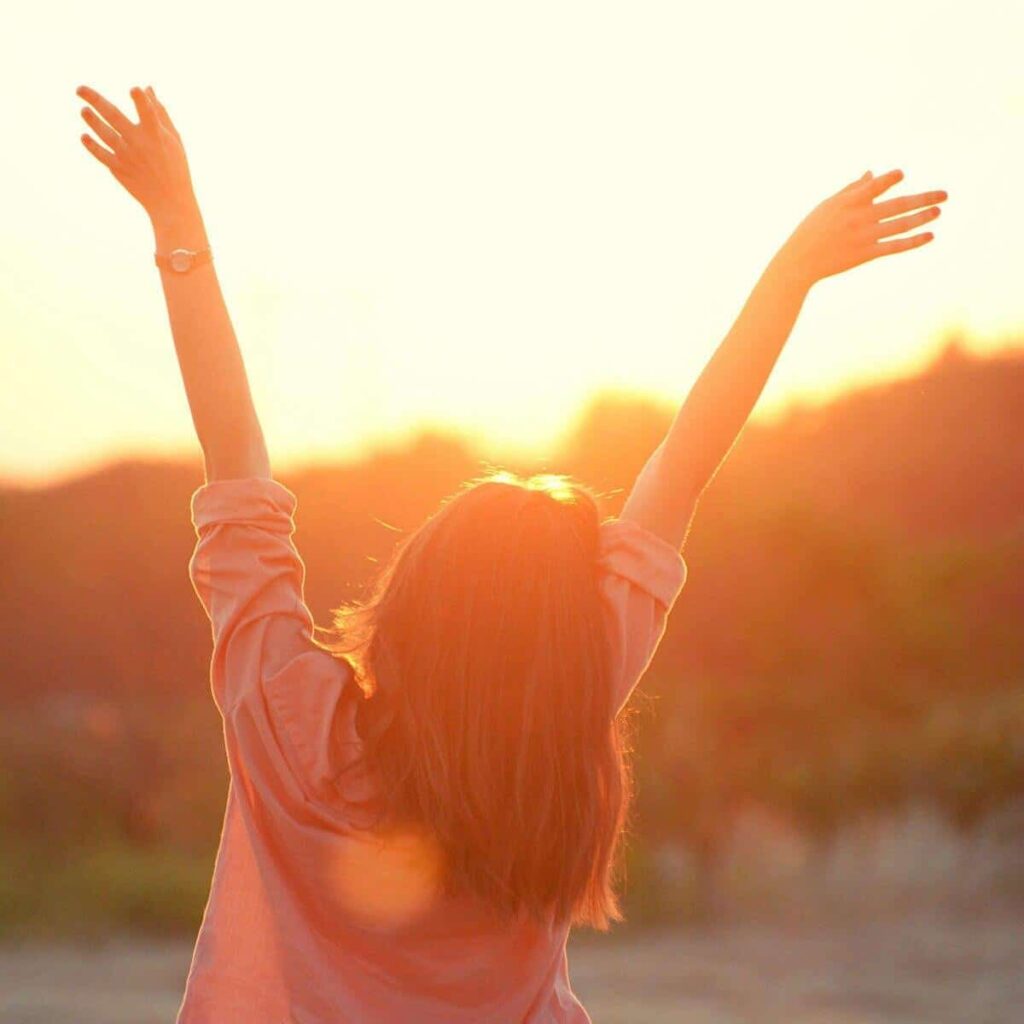
Part 1: Lessons 2020 Has Taught the Health and Wellness Industry
Healthy Lifestyle Choices Are Essential for Disease Prevention
The Background
Despite the efforts of some actors in the nutrition and health industry to try and convince people to buy products and programs that will immediately “boost” their immune system, one thing that COVID-19 has taught us is that we have no control over certain elements of the immune system, like age, current health status, systemic injustice, and genes.
There are, however, certain elements that we do have some control over, namely lifestyle choices like diet, sleep, rest, and physical activity. These elements, which are the result of daily actions, have a significant influence on the health of our immune system and can be effective in reducing disease risk.
A large community-based cohort study that included over 380,000 adults in the UK found that unhealthy lifestyle behaviors accounted for up to half of the cases of severe COVID-19, likely due to low-grade inflammation. The study concluded that adopting lifestyle changes could lower the risk of severe COVID-19 infection.
The Lessons
For health and wellness coaches and health and wellness professionals, the conclusion that the adoption of healthy lifestyle choices significantly reduces the risk of disease is nothing new. This year, for the first time in recent history in most industrialized countries, we saw hospitals at full capacity and a severe lack of equipment to get people the support they needed.
COVID-19 has reiterated the importance of prevention through promoting lifestyle choices. At the same time, the disparities in health environments make it extremely difficult to assume that adopting healthy lifestyle choices is a simple process.
The role of health professionals, like health and wellness coaches, who focus on supporting clients to adopt choices that support their health in a socially and culturally relevant, low-cost, realistic fashion, is needed more than ever. Only when the health system makes space for specialists in healthy lifestyle adoption to support the population will we see a significant change in the risk of developing an illness.
How Health and Wellness Coaches Can Use These Lessons in Their Practice
- Remember that your role in supporting clients and communities to adopt realistic, people-centered lifestyle changes is essential to ensuring long-term health and resilience.
- Work with clients and communities to build programs that help them adopt healthy choices in a way that makes sense for them.
- Advocate for access to tools and resources that are conducive to healthy lifestyles in your own community. This may mean expanding sidewalks and parks, supporting local businesses that offer healthy food options, or working with local public health systems and insurance companies so that your services are covered by insurance.
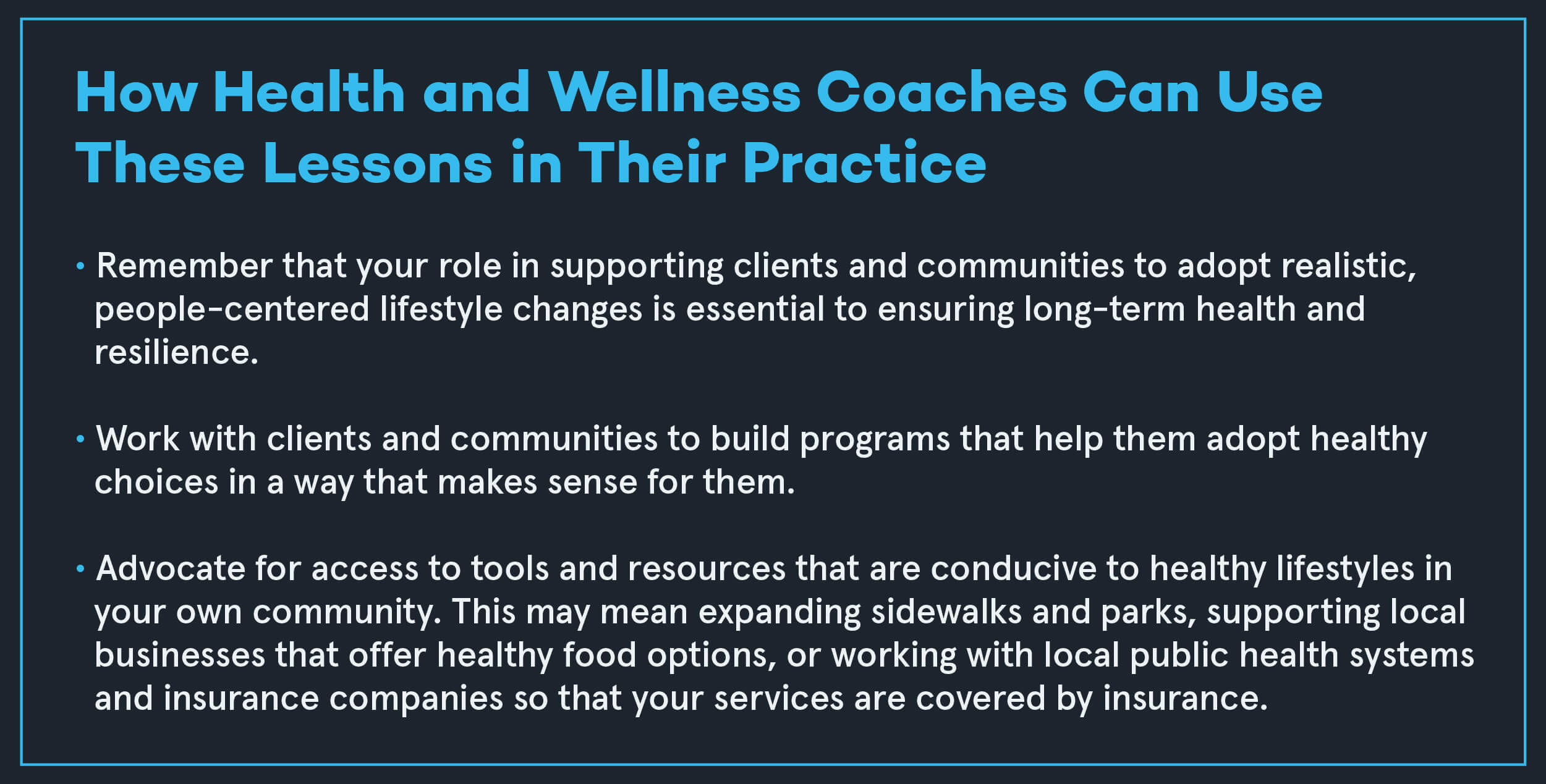
Health Crises Impact ‘Normal’ Lifestyle and Wellness Behaviors
The Background
This may seem like an obvious lesson, but as we all became more aware of the risk of COVID-19 infection and adhered to regulations, we also felt pressure to quickly adapt to a new normal while keeping up with our nutrition and exercise goals.
Health and wellness coaches realized it was more important than ever to care for our health and support clients with health goals, but the circumstances that arose during the pandemic (stay-at-home orders, anxiety, stress, economic limitations, food and supply shortages) were in no way conducive to the healthy lifestyle we were trained to promote.
In the past several months, researchers have published dozens of studies that have assessed how the COVID-19 pandemic has impacted lifestyle. Here are some of the most notable findings:
- The COVID restrictions have had a severe negative impact on physical activity frequency in adolescents and children. While almost 40% of young people were either inactive or carried out insufficient physical activity before the pandemic, the number rose to over 80% during the pandemic. Additionally, the average number of minutes of physical activity per week that young people engaged in during the pandemic is less than a fifth of what it was before the pandemic.
- Stay-at-home orders and isolation have led to loneliness, depression, and anxiety, especially in those with limited social support, which may extend well beyond the pandemic.
- Quarantine restrictions that limited outdoor activities will have negative long-term effects on cardiovascular disease risk due to an unhealthy lifestyle and anxiety.
- In a study carried out in Northern Italy to evaluate the effects of lockdown on sleep, researchers found that over 40% of participants felt that they had worse sleep quality during the lockdown.
- Researchers examined the effect of the COVID-19 pandemic on lifestyle changes in Polish adults. They found that, during the study period, 43% of respondents decreased physical activity, 49% increased screen time, and 34% increased food consumption.
- The nutritional quality of diets decreased in some study populations during the lockdown. Some of the changes in food choices were a result of mood.
The Lessons
This year, we learned the importance of being gentle with ourselves and our clients when falling short of goals. For coach-client relationships to stay strong, we’ve had to learn to adapt, show empathy, and build strong communications networks.
Stress and anxiety are normal responses to health crises, and everyone reacts differently to stress and anxiety.
We’ve also reinforced the importance of adapting our guidance to different client needs. While some clients may have had newly found time and motivation to implement actions to improve their health, others may have had to significantly scale back on their expectations as they juggled work, childcare, emotional health struggles, and others.
How Health and Wellness Coaches Can Use These Lessons in Their Practice
- Work on building a toolbox of realistic and flexible recommendations that help people stay active, meet nutritional needs, and care for their emotional health during a health crisis or other unexpected circumstances.
- Show empathy when your clients are not meeting their goals or following through with commitments.
- Work with clients to take stock of their current needs and limitations and restructure their plan as needed.
- Consider using a questionnaire or similar tool to assess recent changes in lifestyle to adapt your coaching plan as needed.
- Care for your own health and recognize your own needs and limits to avoid burnout.

Systemic Injustice Continues to Be at the Root of Many Health Problems
The Background
Racism Toward and Discrimination of BIPOC Communities Is Still Widespread
Without a doubt, the year 2020 has shed light on devastating disparities in access to health, education, justice, and employment. The COVID-19 pandemic has disproportionately affected communities of color across America, emphasizing the centuries-long disparities that continue to be prevalent today. The Black Lives Matter movement and the preceding civil rights movements have brought attention to these disparities, not only in 2020 but in decades past, but the disparities are far from being corrected.
Mental Health America explains the impact of these disparities: “These disparities have a dual impact—not only are they resulting in differences in the actual care and treatment that COVID-19 patients receive, but they also put people in BIPOC communities at higher risk of contracting COVID-19 in the first place.”
Here are some of the data:
- Black people make up about 15% of the US population but at least 27% of COVID-19 cases in the US.
- Black people in the US are 2.5x more likely to die of COVID-19 than white people.
- Black Americans who are not essential workers are more likely to lose their jobs due to COVID-19, and their unemployment rate continues to rise while unemployment among white people is recovering.
- Latinx communities are two-thirds more likely than the general population to receive a pay cut or lose their job as a result of COVID-19.
- Latinx demographics are largely employed in the service industry or in essential jobs. Many service industries crashed, leading to job loss, while essential jobs, like those in grocery stores or hospitals, increased their risk of infection from COVID-19.
- The Navajo Nation has the highest rate of infection per capita when compared to any other state.
- Hospitals that serve Native Americans and Indigenous communities are seriously lacking in hospital beds, with only 1,397 hospital beds and 10 ventilators for over 2.5 million Native Americans and Indigenous people in the US.
- Infection and mortality data for BIPOC communities is likely underreported, as some states categorize BIPOC individuals as “other” in data sheets.
- Increased racism and xenophobia against Asian and Pacific Islander communities in the US has resulted in accumulated trauma and severe negative impacts on employment and income.
You can see more data on Mental Health America and the resources they provide.
LGBTQ+ Communities Invisibilized in Health System and Lack Basic Access to Healthcare
The Human Rights Campaign Foundation published a brief that examined the impact of the COVID-19 pandemic on LGBTQ+ people. Some of the key data are as follows:
- LGBTQ+ people are going undocumented in COVID-19 health data when forms only have the options of “Male,” “Female,” and “Other.”
- LGBTQ+ communities are in highly affected industries, including food services, hospitals, education, and retail.
- 17% of LGBTQ+ adults do not have any kind of health insurance compared to 12% of non-LGBTQ+ adults.
- Economic fluctuations, like those that have occurred as a result of COVID-19, put LGBTQ+ more at risk; LGBTQ+ people are poorer than their straight and cisgender counterparts (22% compared to 16%), with Black and Latinx transgender individuals being most economically at risk (40% and 45% respectively).
- Older LGBTQ+ people are twice as likely to be living alone and four times less likely to have children, making them especially at risk of lacking care or support from family.
- LGBTQ+ have health risk factors that increase their risk of exposure and complications due to COVID-19.
Another key event occurred in 2020 that will affect queer and transgender individuals beyond the pandemic. In June of 2020, the US federal government finalized a rule that removed nondiscrimination protections for transgender people to be able to gain equal access to healthcare and health insurance. This rule validates discrimination practices that public health insurance and private health insurance companies adopt to exclude transgender healthcare protections.
The Lessons
The health system, along with many other systems in the US, severely disfavors BIPOC and LGBTQIA+ communities, and the distribution of employment makes BIPOC communities more vulnerable to job loss and, simultaneously, an increased risk of exposure to the virus.
The lesson here is as follows: The US needs to do better. Public health programs need to extend culturally adequate health services to BIPOC and LGBTQIA+ communities, distribute funding for health systems more equally, and provide free and low-cost healthcare options.
Other systems, from education to the economy, also have a vital role in closing the disparities. Communities and the systems that govern them need to guarantee high-quality education, from elementary to college, so that they can have greater access to diverse, stable, and higher-paying job opportunities. At the same time, the individuals and those leading organizations within these oppressive systems need to examine their own role in perpetuating these disparities.
How Health and Wellness Coaches Can Use These Lessons in Their Practice
As you read the lessons above, it might seem overwhelming. What can you do as a health coach to help address these disparities?
- Examine your personal biases against BIPOC, LGBTQIA+, and minority communities, and educate yourself.
- Examine your programming and business model. Make it accessible to and adequate for diverse populations.
- Examine your health forms to ensure that they are inclusive of different identities.
- Listen to your clients and their needs. You can learn as much from them as they can learn from you.
- When appropriate, advocate for your clients within health systems. Help them navigate health systems and find support when needed.
- Get involved in health coach networks and communities to ensure equal opportunities for BIPOC and LGBTQIA+ communities to become coaches.
- Educate yourself on disparities and biases within health and education institutions that continue to generate disparities.
- By nature, a true wellness approach is inclusive and multicultural. Review your business and program model to ensure that it is true to this approach.
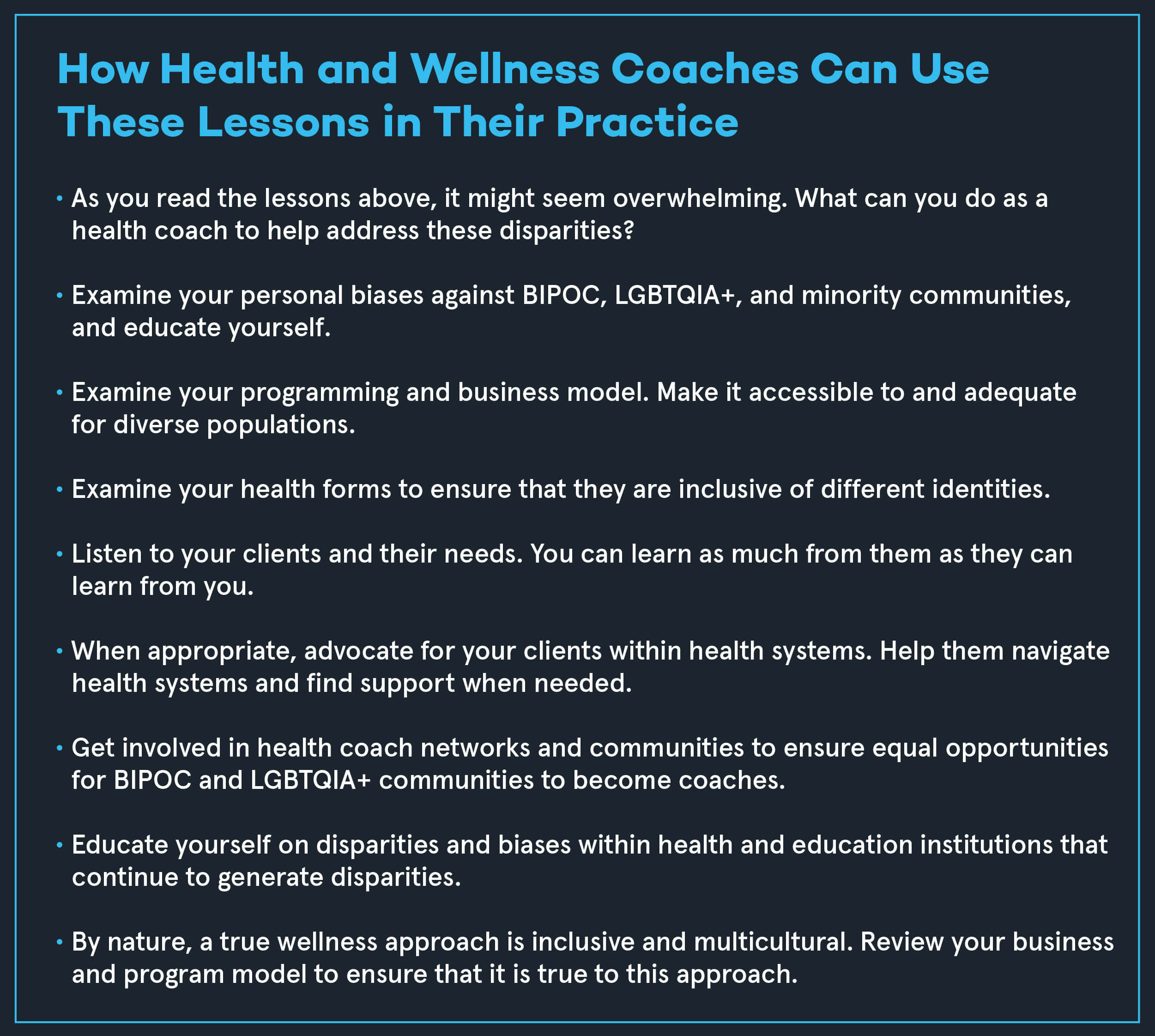
Wellness Is Just as Important as Physical Health
The Background
Health and wellness professionals and coaches have known this for a long time, but it took a year like 2020 for many industries to fully understand that health isn’t only about the lack of physical illness.
Health and wellness are closely related. Health is generally considered a “state” of being.
There are many definitions of wellness, but one of the most commonly cited is that of the National Wellness Institute: “Wellness is an active process through which people become aware of, and make choices toward, a more successful existence.” By this definition, wellness can only be achieved by ensuring the fulfillment of six dimensions of wellness: physical, social, intellectual, spiritual, emotional, and occupational. Western Connecticut University adds cultural wellness as the seventh dimension of wellness. The US Department of Health and Human Services brings together emotional, psychological, and social wellbeing under the term “mental health.”
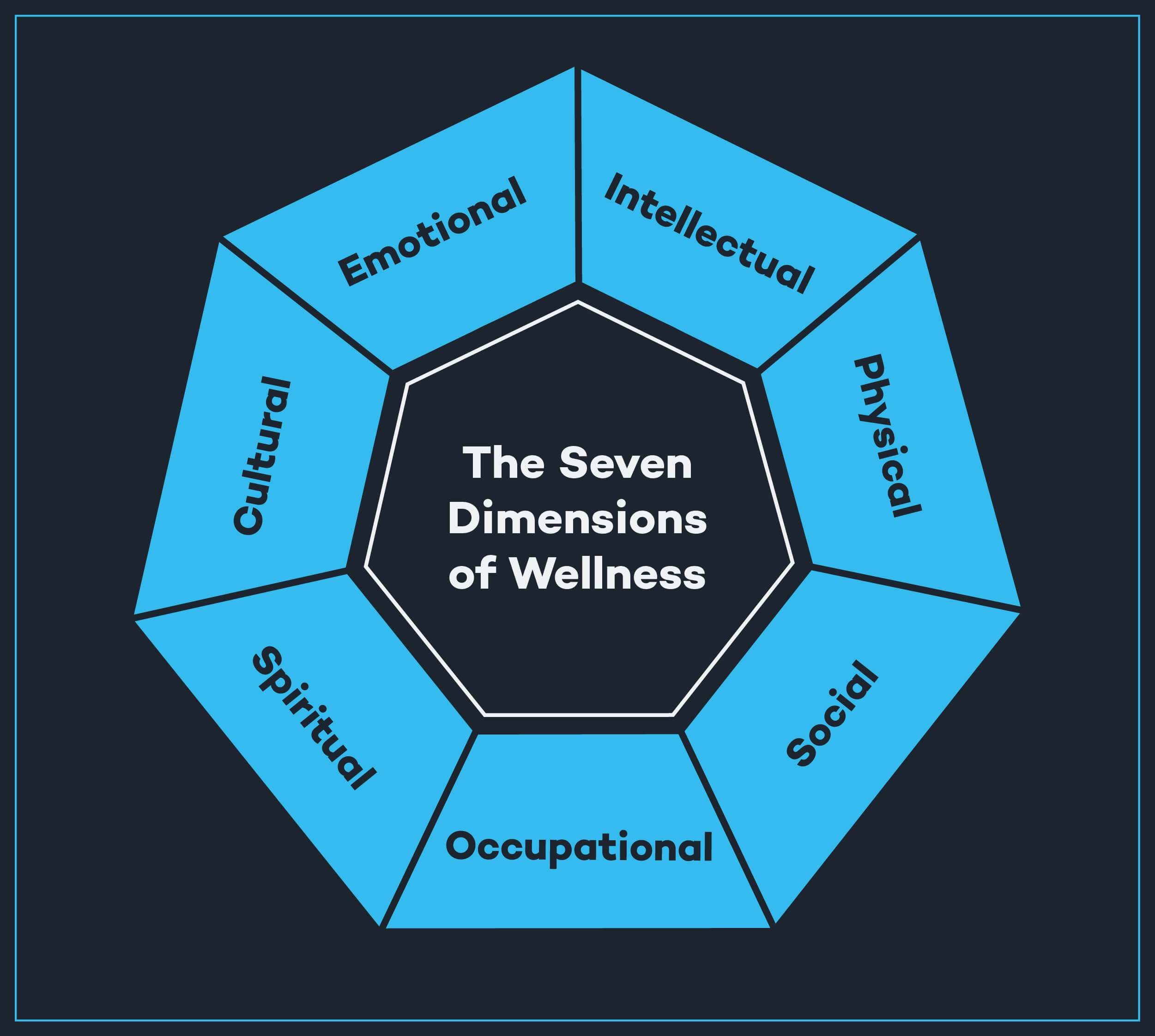
The National Wellness Institute is far from alone in its global vision of health and wellness. In fact, the World Health Organization uses the term “wellbeing” to define health: “a state of complete physical, mental, and social wellbeing, and not nearly an absence of disease or infirmity.”
In short, wellness could be considered the means by which a person reaches and maintains a state of health and wellbeing.
So, what does this have to do with what we have learned in 2020?
The challenges brought on by COVID-19, civil rights movements, job loss, and natural disasters have demonstrated that even when a person is doing well in one dimension of wellbeing, another may not be fulfilled, and thus are not well nor healthy.
For example, by following strict stay-at-home orders, people were protected from COVID-19, a virus that threatens the physical aspect of health. But in doing so, many individuals felt extremely lonely, longed to participate in their religious communities, lost their jobs, or were unable to continue their studies. In short, other dimensions of mental health or wellness have suffered as a result of respecting stay-at-home orders and social distancing recommendations.
While the state of wellness hasn’t been adequately measured throughout 2020, the CDC has been monitoring mental health in the US since the pandemic began. Some of the data are as follows:
- There are rising levels of worry, anxiety, and fear in older people, children, and people with underlying health conditions.
- Medical staff are experiencing extreme psychological pressure.
- Anxiety and depression are up significantly compared to 2019.
These changes occurred when the US was already seeing drastically rising levels of mental health issues over the past several years.
The Lessons
In 2020, all different aspects wellbeing have been challenged.
- Physical wellbeing has been highlighted and challenged with widespread cases of injustice toward BIPOC people; the threat of the coronavirus, more stress on underlying conditions, especially chronic diseases; and infectious diseases and mortality resulting from natural and manmade disasters.
- Social wellbeing is challenged with stay-at-home orders, isolation of people most at risk of developing severe COVID-19, and BIPOC communities realizing their social groups are perpetuating racial stereotypes.
- Intellectual wellbeing is challenged as people can no longer afford to go to school after they or their caretakers have lost jobs, or they feel that they aren’t benefiting from online education.
- Spiritual wellbeing is affected by social distancing and hygiene restrictions that limit people’s ability to engage in their spiritual practice fully, and xenophobia and racism don’t allow people to feel safe when practicing their spirituality.
- Emotional wellbeing has taken a toll with ongoing trauma to BIPOC communities, dealing with the loss of family members due to COVID or natural disasters, and the emotional impact of anxiety, depression, and worry.
- Occupational wellbeing is at risk when a person loses their job, has greater income requirements due to a family member’s job loss, experiences income loss, or is no longer physically able to carry out their occupation.
- Cultural wellbeing is threatened by outright and occult xenophobia and racism that BIPOC communities experience daily.
How Health and Wellness Coaches Can Use These Lessons in Their Practice
- Stay up-to-date with the latest mental health trends.
- Focus on all aspects of wellness with your clients.
- Offer your services to companies and organizations to help make working environments more conducive to wellness in the context of a pandemic, social and racial inequity, and beyond.
- Educate yourself on when to refer your client to another health professional trained specifically to support clients with those aspects of their lives. Some other professionals may include mental health professionals, therapists, unemployment agents, social workers, cultural center directors, and more.
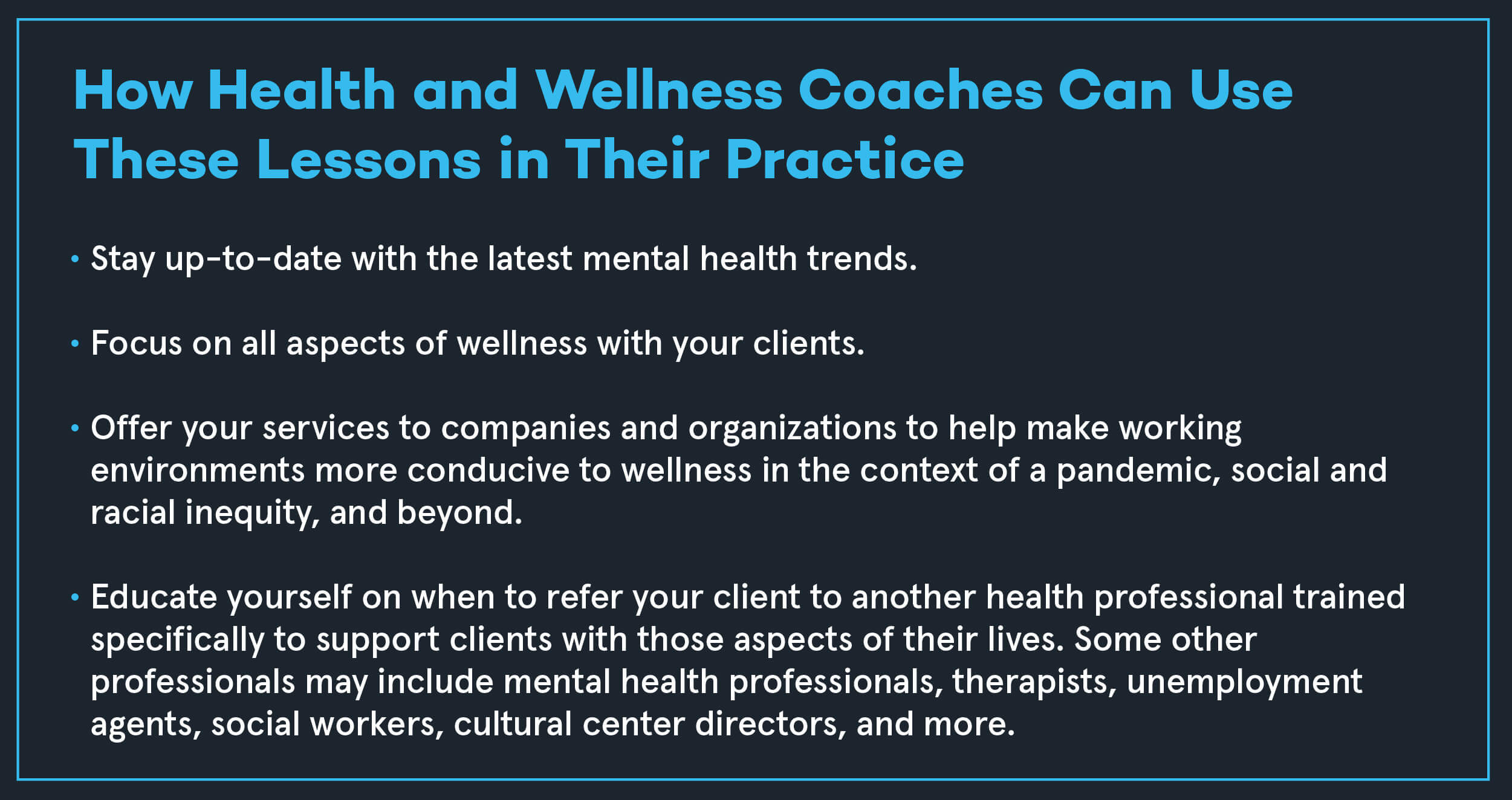
Coming Up…
This article is part one of the two-part article series we have developed as a result of AFPA’s reflection on the lessons 2020 has left the health and wellness industries.
In next week’s article, you will read about what 2020 has taught us about the role of work environments in wellness, the fragility of the food system, and importance of online technology in extending health services to the population.



